The Hatches
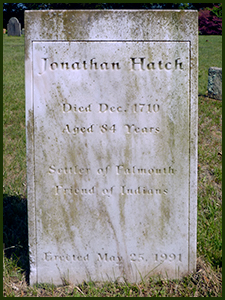 The story of the Frances A. Crane Wildlife Management Area begins in 1660 when Jonathan Hatch acquired land from the Succonessett Indians on behalf of a small group of settlers from Barnstable. Having arranged the purchase and built the first log dwelling (at Mill Road), Jonathan Hatch served as the group's leader and his home their meeting place, eventually to be licensed as a public house. He and his wife Sarah Rowley had 11 children, the last 4 born in Succonessett. The township's name changed to Falmouth upon incorporation in 1686, and in 1691 a second land purchase from the Wampanoag expanded the town north and east to its current boundaries.
The story of the Frances A. Crane Wildlife Management Area begins in 1660 when Jonathan Hatch acquired land from the Succonessett Indians on behalf of a small group of settlers from Barnstable. Having arranged the purchase and built the first log dwelling (at Mill Road), Jonathan Hatch served as the group's leader and his home their meeting place, eventually to be licensed as a public house. He and his wife Sarah Rowley had 11 children, the last 4 born in Succonessett. The township's name changed to Falmouth upon incorporation in 1686, and in 1691 a second land purchase from the Wampanoag expanded the town north and east to its current boundaries.
One of Jonathan and Sarah's sons (Joseph Hatch) had 14 children of his own, of whom Ebenezer was the first Hatch to move to the East End around 1740. He and his wife Mercy Crocker settled on Deep Pond. Their sons and grandsons consolidated their family farms on the northwest side of Coonamessett Pond, which provided water for their dairy cows. They grew hundreds of acres of corn on the flat plain at the posted coordinates.
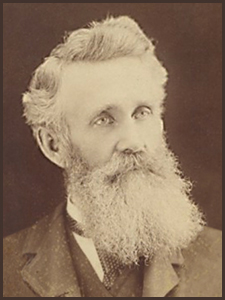 By 1858 there were 160 residents of the East End, including 40 Hatches, with the remainder from 13 other families. Silas Hatch was the great-grandson of Ebenezer and an influential figure. His home on Boxberry Hill Road was the village meeting place, and also became its post office after President Buchanan appointed him the first postmaster of "Hatchville." He served until 1919 at that site ¼-mile south of Happy Cache.
By 1858 there were 160 residents of the East End, including 40 Hatches, with the remainder from 13 other families. Silas Hatch was the great-grandson of Ebenezer and an influential figure. His home on Boxberry Hill Road was the village meeting place, and also became its post office after President Buchanan appointed him the first postmaster of "Hatchville." He served until 1919 at that site ¼-mile south of Happy Cache.
The Cranes
Meanwhile in Chicago, 1855 was the year Richard Teller Crane established his brass foundry which would grow into the multinational Crane Co. manufacturing all manner of steam pipes and fittings for railroads, central heating systems, navy warships, even the railings on the Golden Gate bridge, elevators, vending machines, and the bathroom fixtures in American homes between 1920-1980. The senior Crane and his wife Mary Prentice had 11 children. Their eldest (Charles Richard Crane) and youngest (Richard Teller Crane, Jr.) sons joined their father in the business. Daughter Frances Williams Crane married Frank Lillie, a biology professor at the University of Chicago. In the summers, Frank served as director of the Marine Biological Laboratory (established 1888) and the Lillies lived in Woods Hole.
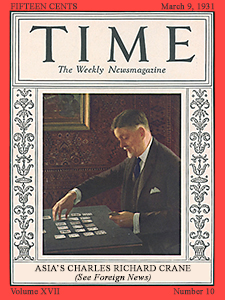 Already a wealthy businessman, Charles Crane's true interests were travel, cultural studies, diplomacy and philanthropy. In 1900 he visited his sister in Woods Hole and gave the Lillies a generous gift ($30 million in today's dollars) to construct the Crane Laboratory at MBL. He determined that Falmouth was a good place to invest. By 1914 he had retired from the Crane Co., purchased a summer estate at Juniper Point, built homes nearby for his adult children, and begun buying land from Hatchville farmers under a new venture. His partners were his son Richard Teller Crane III, son-in-law Robert Leatherbee (married to his daughter Frances Anita Crane), Robert's brother Frederick Leatherbee, and Wilfrid Wheeler (the state Secretary of Agriculture, married to Frank Lillie's sister Emily). Using Charles Crane's funds, the Coonamessett Ranch quickly grew to 14,000 contiguous acres, the largest landholding east of Chicago.
Already a wealthy businessman, Charles Crane's true interests were travel, cultural studies, diplomacy and philanthropy. In 1900 he visited his sister in Woods Hole and gave the Lillies a generous gift ($30 million in today's dollars) to construct the Crane Laboratory at MBL. He determined that Falmouth was a good place to invest. By 1914 he had retired from the Crane Co., purchased a summer estate at Juniper Point, built homes nearby for his adult children, and begun buying land from Hatchville farmers under a new venture. His partners were his son Richard Teller Crane III, son-in-law Robert Leatherbee (married to his daughter Frances Anita Crane), Robert's brother Frederick Leatherbee, and Wilfrid Wheeler (the state Secretary of Agriculture, married to Frank Lillie's sister Emily). Using Charles Crane's funds, the Coonamessett Ranch quickly grew to 14,000 contiguous acres, the largest landholding east of Chicago.
The modern, mechanized "model farm" was unable to turn a profit in the post-war years, so in 1925 the company converted 900 acres to the Coonamessett Ranch Resort. It began with the stately Coonamessett Inn on the north shore of Coonamessett Pond; the beach is still there, and a bit of the parking lot (at GC5A6RG). 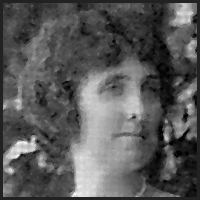 Over the next 20 years, the resort added the Coonamessett Airport (seaplanes also landed on the pond), a golf course (now the Cape Cod Country Club), tennis courts, a stable, a polo field (at GC25HG2), a nightclub, a playhouse, rental cottages and a motel. By then Francis Anita Crane had divorced Robert Leatherbee, and her next husband as well. A tall socialite with a strong personality, she was known in Falmouth as Madame Crane. Upon their father's death, she and her brother John Oliver Crane became the administrators of Coonamessett Associates. In 1954, Frances A. Crane was killed in a late-night car accident returning home from an opening at the Falmouth Playhouse.
Over the next 20 years, the resort added the Coonamessett Airport (seaplanes also landed on the pond), a golf course (now the Cape Cod Country Club), tennis courts, a stable, a polo field (at GC25HG2), a nightclub, a playhouse, rental cottages and a motel. By then Francis Anita Crane had divorced Robert Leatherbee, and her next husband as well. A tall socialite with a strong personality, she was known in Falmouth as Madame Crane. Upon their father's death, she and her brother John Oliver Crane became the administrators of Coonamessett Associates. In 1954, Frances A. Crane was killed in a late-night car accident returning home from an opening at the Falmouth Playhouse.
The Commonwealth
The Coonamessett Ranch began to dissolve as its focus shifted to an inland summer resort. The Leatherbees bought large parcels from the company and succeeded the Hatch family as prominent producers of dairy, poultry, strawberries, corn and vegetables. Wilfrid Wheeler also purchased 300 acres as his personal horticulture farm; that land is 2 miles east of here and is now Mass Audubon's Ashumet Holly Reservation. In 1935, 8700 acres were sold to the Massachusetts National Guard training facility at Camp Edwards.
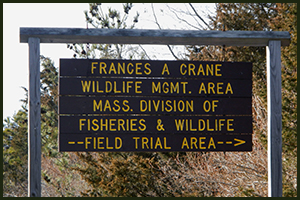 Frances Anita and John Oliver Crane ran the company for 15 years, but after her passing the family had no interest in continuing. The resort's assets (the inn, the airport, the playhouse, etc.) were sold piecemeal to people such as Harvey Clauson who gave his name to Clauson's Corner (Sandwich Road at Rt 151). Four years after her death, Frances' sons Charles, Richard and Robert sold the last 1500 acres to the Massachusetts Division of Fisheries & Wildlife. The land was to be used as a Wildlife Management Area and named for their mother.
Frances Anita and John Oliver Crane ran the company for 15 years, but after her passing the family had no interest in continuing. The resort's assets (the inn, the airport, the playhouse, etc.) were sold piecemeal to people such as Harvey Clauson who gave his name to Clauson's Corner (Sandwich Road at Rt 151). Four years after her death, Frances' sons Charles, Richard and Robert sold the last 1500 acres to the Massachusetts Division of Fisheries & Wildlife. The land was to be used as a Wildlife Management Area and named for their mother.
The Puzzle
All you have to do now is fill in the answers below. No outside research necessary, just reading comprehension.
N 41° A B . C D E W 070° F G . H I J
A = Number of Frances A. Crane's sons who sold her land holdings to MassWildlife.
B = Last digit of the year of sale in #A.
C = Number of centuries between the Hatch patriarch and the Crane patriarch.
D = Number of generations between Proprietor Hatch and Postmaster Hatch.
E = Thousands of acres of Crane-owned land converted to military use.
F = Third digit of the year Ambassador Crane was on the cover of Time.
G = Number of Frances A. Crane's marriages.
H = Third digit of the year of Madame Crane's untimely death.
I = Number of directors of the Coonamessett Ranch Company.
J = Number of Coonamessett Ranch founders who were Cranes.
Historical information from Les Garrick's 2014 book, Historic Hatchville, and other sources.
Self-grade your quiz.
About the Cape Cod Mini Star series